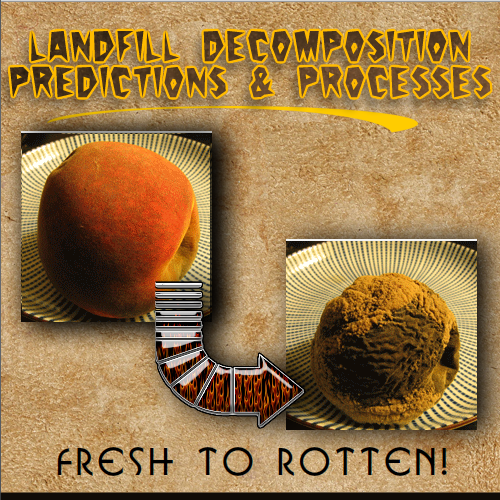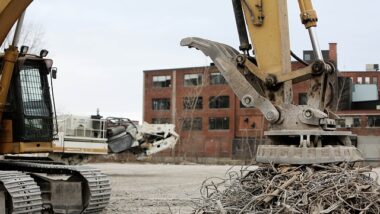Waste Decomposition: The Main Stages of waste decomposition, otherwise known as the waste degradation process
An understanding of the Main Stages of waste decomposition. Which is alternatively called “the waste degradation process” is essential to understand how a landfill will gradually change over many years.
We are often asked how many years will it take before a particular landfill can be built upon, or will no longer require leachate treatment?
The inability of landfill professionals to provide a quick question often surprises questioners.
Unfortunately, there are so many reactions which coincide within a landfill that predictions are hard to come buy. There are many sites on the web that give periods for different materials to rot away, with apparent confidence.
Our view is that most such predictions that we have seen, are too short, and so generalized as to be meaningless.
We hope that this article will help provide readers with an understanding of the difficulties in the prediction of landfill degradation rates. Forecasting when all the processes involved will have run their paths and degradation have been completed depends on the processes of decay involved. These vary according to many environmental factors, and especially according to the presence or not, of oxygen.
Flushing with Fresh Water from Rainfall Before Landfills Can Be Returned for New Uses
Furthermore, even after degradation processes have significantly ceased, many landfills will still need further flushing with water. Flushing with fresh water will be needed before the leachate produced becomes innocuous and harmless to the environment.

Attribution: Andrew Dunn, http://www.andrewdunnphoto.com/
Society's experience with the present designs of sanitary landfills is very short. Over the past thirty to forty years the increasing size/more rapid filling and improved containment/capping of landfills, has led to progressively higher waste densities and lower water contents.
This has has, no doubt, massively extended the degradation periods of landfills.
At the start of this period most landfills were:
- small and shallow
- would remain uncapped and aerobic throughout,
- did not contain significant plastics, and
- would be quite rapidly degraded and rendered harmless; if not in 10 years, within a few tens of years.
Large modern landfills, are normally kept as dry as possible, and capped quickly in order to comply with leachate management procedures. These seek to minimise landfill leachate production to reduce leachate disposal costs during the active life of the landfill. This is the same for the new (Post: implementation of EU Landfill Directives) generation of mono-disposal hazardous waste landfills.
All of them will take thousands of years to decompose to the point where all pollution potential has been neutralised.
The Aerobic to Anaerobic Sequence
The first point to note about the decomposition of landfills is that the characteristics of a landfill are primarily governed by the presence or otherwise of aerobic or anaerobic conditions.
Clearly, on Day 1, all landfills start off being aerobic (there will be a plentiful surplus of air/ oxygen).
However, fairly soon all modern landfills become anaerobic in large parts of the landfill, as more waste is deposited above and around the waste.
As more waste is placed around and on top of earlier waste, the ability of oxygen to diffuse into the waste-mass is lost within the body of the wastes. From that point onward a landfill becomes anaerobic and stays anaerobic for a very long time.
The conditions within the landfill are very much governed by the presence or otherwise of anaerobic conditions, so let us consider the effects of this.
The Aerobic, Anaerobic and Back to Aerobic Sequence
Logically, all modern sanitary landfills will eventually, at some undefined future date, return to the aerobic state when all significant oxygen-demanding reactions have ceased.
When the waste stops consuming oxygen a slow process of air-diffusion will allow the air/ oxygen to flow back-into the whole landfill, and not be consumed (i.e. return to being aerobic).
This can be called the final rest state for a landfill.
How Long is Needed for a Landfill to Cease to Pose an Environmental Risk?
Now, to answer the question of: “How many years will it take?”
It is truly unrealistic to say anything more definitive than that this will take from hundreds of years, to one or more thousands of years.
The diagram below should provide a broad overview of the complex stages of biological decomposition in a landfill:

Printable version for those with Microsoft PowerPoint (Tm).
Decomposition – A Definition from Wikipedia
Decomposition is the process by which organic substances are broken down into a more simple organic matter. The process is a part of the nutrient cycle and is essential for recycling the finite matter that occupies physical space in the biosphere. Bodies of living organisms begin to decompose shortly after death. Animals, such as worms, also help decompose the organic materials. via en.wikipedia.org
Aerobic Waste Decomposition Means Mininum Bad Odours!
Aerobic oxidation of organic matter produces no objectionable odor. If odors are noticeable, either the process is not entirely aerobic or there are some special conditions or materials present which are creating an odor. Aerobic decomposition or composting can be accomplished in pits, bins, stacks, or piles, if adequate oxygen is provided. Turning the material at intervals or other techniques for adding oxygen is useful in maintaining aerobic conditions.
Anaerobic Decomposition is What Smells!
Anaerobic decomposition results in a compost (often called a digestate) which can have a strong odor (and may need to be aired prior to using), it is not usually the first choice in compost for gardening home owners.
The reason for that is generally that it has an unpleasant odor when first exposed to the air.
High temperatures are needed for the destruction of pathogens and parasites. Suitable high temperatures can be created during aerobic composting usign the heat generated by the aerobic decomposition process.
Comparison of Destruction of Pathogens and Parasites During Anaerobic and Aerobic Digestion (Decomposition)
The destruction of pathogens and parasites more difficult in anaerobic digestion. The digestion process generates far less heat, and in all but the hottest countries to achieve this will need added heat, usually by burning some of the biogas produced by the process.
In anaerobic decomposition the pathogenic organisms do eventually disappear in the organic mass, as a result of the unfavorable environment and biological antagonisms. However, the disappearance is relatively slow, and the material must be held for periods of six months to a year to ensure relatively complete destruction of pathogens, such as the eggs of Ascaris, nematodes which are among the most resistant of the fecal-borne disease parasites in wastes. via aggie-horticulture.tamu.edu
Decomposition of Plastic Waste in Landfills
Plastic waste is one of many types of wastes that take too long to decompose. Normally, plastic items can take up to 1000 years to decompose in landfills.
Plastic products are very common in our modern life. According to estimates, every year in the US they use approximately 1.6 million barrels of oil just for producing plastic water bottles.
But plastic bags we use in our everyday life take 10-1000 years to decompose, while plastic bottles can take 450 years or more.
Just in the United States alone, every year more than 18 billion disposable diapers are thrown away. These disposable diapers take approximately 250-500 years to decompose in landfills.
This underscores the efforts of programs reducing plastic use, and points to the benefits of those companies offering diaper and absorbent hygiene product recycling. via www.thebalancesmb.com
What is Landfill Gas?
Landfill gas is a mixture of methane and carbon dioxide produced by the anaerobic decomposition of organic waste. It contains other trace gases, including hydrogen sulfide, which gives it an unpleasant odor. Understanding landfill gas is key to managing environmental impact and exploring renewable energy opportunities…
Landfill Sites – 3 Compelling Reasons to Bury the Use of Dumps
Landfill Sites are not sustainable, and here are 3 compelling reasons to bury the idea that we continue to use landfills (dumps) for municipal waste beyond the next 10 years. All waste has to be disposed of in a safe manner. If not it is a major health problem in densely populated urban areas, second […]
Aerobic Landfill and Why The Subject Will Not Be Forgotten
A key topic raised in many countries, not least Japan, is why most other industrialized nations have gone so strongly for sanitary landfill design, which locks up waste and only slowly allows it to decompose with air (anaerobically) and not aerobic landfills which rot away quickly. The awful longevity of sanitary landfilling, becomes clear when […]
Waste Decomposition – Sanitary Landfills a 1,000 Year Liability
Government Sponsored Research Shows Slow Waste Decomposition Means Landfills Present 1000 Year Liability (This article is based upon one which we first wrote for this website in 2004. The issues raised remain largely un-addressed and we think that they are as pertinent today as they were at the time.) Research published in September 2004, which was […]











Hello, I was wandering around online and I saw your site from another site. In discussing waste decomposition your article, cleared up some confusion I was holding. I read a few of your posts and found them well written. Thanks, I will surely visit your page again soon.
The idea that plastics do eventually decompose is a flat-out lie.
Plastics degrade into ever smaller pieces until you can’t see them anymore (so small you’d need a microscope or better!).
Most commonly used plastics do not mineralize (or go away) in the ocean and instead break down into smaller and smaller pieces.
Couple that with their tendency to float or since just below water level they stay very much in the zone of maximum biological activity on earth.
Great article. Landfills are pretty poor things all round. But, do you think they will one-day be all dug out again and the materials used again?